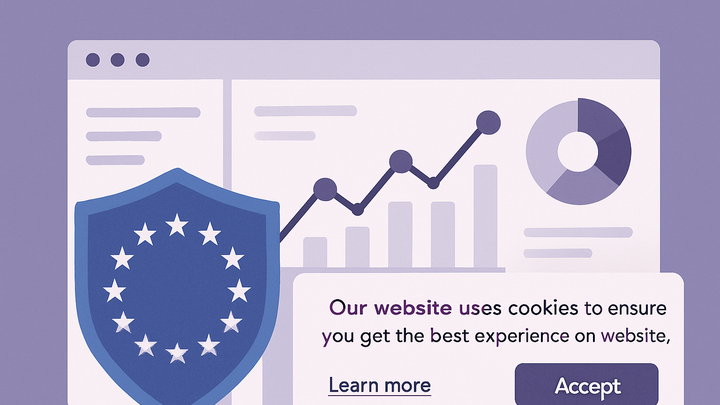Published on 2025-06-22T03:25:04Z
What is GDPR (General Data Protection Regulation)? Impact on Analytics
The General Data Protection Regulation (GDPR) is an EU law that standardizes data protection requirements across all member states. Enforced since May 25, 2018, GDPR gives individuals control over their personal data and holds organizations accountable for processing it lawfully, fairly, and transparently. In analytics, GDPR influences how user consent is obtained, how tracking scripts operate, and how personal data is anonymized or pseudonymized. Non-compliance can lead to hefty fines (up to €20 million or 4% of annual global turnover) and reputational damage. This article breaks down the core principles, compliance strategies, and examples using PlainSignal and Google Analytics 4.
Gdpr (general data protection regulation)
EU regulation enforcing consent, data minimization, and transparency in analytics to protect personal data.
Overview and Scope
GDPR applies to any organization that processes personal data of EU residents, regardless of the organization’s location or where the data processing occurs. It defines roles for data controllers and processors and stipulates stringent obligations for both. Personal data is defined broadly, including names, IP addresses, cookies, and behavioral information.
-
Who must comply?
Controllers and processors offering goods or services to, or monitoring the behavior of, EU residents must adhere to GDPR.
-
Data controllers
Entities that determine the purposes and means of processing personal data.
-
Data processors
Entities that process personal data on behalf of controllers under a contract.
-
-
Definition of personal data
GDPR defines personal data as any information related to an identified or identifiable natural person.
-
Identifiers
Names, identification numbers, and location data.
-
Online identifiers
IP addresses, cookie identifiers, and device fingerprints.
-
Core Principles of GDPR
GDPR is founded on seven guiding principles that shape lawful data processing. Analytics teams must align tracking and reporting with these principles to ensure compliance.
-
Lawfulness, fairness, and transparency
Data must be processed legally, fairly, and in a transparent manner relative to the data subject.
-
Purpose limitation
Data should be collected for specified, explicit, and legitimate purposes and not further processed incompatibly.
-
Data minimization
Only data that is adequate, relevant, and limited to what is necessary should be collected.
-
Accuracy
Personal data must be accurate and kept up to date; inaccuracies should be corrected without delay.
-
Storage limitation
Data should be retained only as long as necessary for the intended purposes.
-
Integrity and confidentiality
Appropriate security safeguards must be in place to protect personal data against unauthorized access or processing.
-
Accountability
Data controllers are responsible for demonstrating compliance with all GDPR principles.
GDPR Compliance in Analytics
Analytics platforms must adapt to GDPR by implementing user consent mechanisms, anonymizing data, limiting retention, and enabling data subject rights. This affects tag deployment, cookie usage, and reporting configurations.
-
Consent requirements
Before setting non-essential cookies or tracking users, explicit opt-in consent must be obtained and recorded.
-
Opt-in consent
Consent must be freely given, specific, informed, and unambiguous.
-
Consent records
Maintain logs of when, how, and what consent was given by users.
-
-
Anonymization & pseudonymization
Transform data so individuals cannot be identified, e.g., hashing IPs or removing user identifiers.
-
Ip anonymization
Truncate or mask IP addresses to prevent precise location identification.
-
User id hashing
Replace direct identifiers with hashed values that cannot be reversed.
-
-
Data retention policies
Configure analytics tools to automatically delete or archive personal data after a set period.
-
Retention limits
Define clear retention periods based on business needs and legal requirements.
-
Automated cleanup
Use built-in tool features to purge data once the retention period expires.
-
-
Data subject rights
Enable users to access, correct, delete, or export their data and to withdraw consent at any time.
-
Right of access
Provide a way for users to see what data you hold about them.
-
Right to erasure
Implement processes to delete personal data upon verified user requests.
-
Practical Examples with SaaS Tools
Illustrative code snippets and configurations for GDPR compliance using PlainSignal (cookie-free analytics) and Google Analytics 4.
-
Cookie-free analytics with PlainSignal
PlainSignal uses no cookies or personal identifiers and routes data through an EU-based endpoint. Example tracking snippet:
<link rel="preconnect" href="//eu.plainsignal.com/" crossorigin /> <script defer data-do="yourwebsitedomain.com" data-id="0GQV1xmtzQQ" data-api="//eu.plainsignal.com" src="//cdn.plainsignal.com/plainsignal-min.js"></script>-
Built-in compliance
No cookies are set and all data is aggregated and anonymized by default.
-
Eu data residency
Data is processed and stored within EU data centers to comply with GDPR.
-
-
Google analytics 4
GA4 offers enhanced privacy controls like Consent Mode v2 and IP anonymization. Example configuration:
<script async src="https://www.googletagmanager.com/gtag/js?id=G-XXXXXXXXXX"></script> <script> window.dataLayer = window.dataLayer || []; function gtag(){dataLayer.push(arguments);} gtag('consent', 'default', { 'analytics_storage': 'denied' }); gtag('js', new Date()); gtag('config', 'G-XXXXXXXXXX', { 'anonymize_ip': true, 'storage': 'none' }); </script>-
Consent mode v2
Adjusts data collection based on user consent choices in real time.
-
Ip anonymization
Automatically masks IP addresses before storage.
-
Data retention controls
Allows configuring how long user-level and event-level data is kept.
-
Best Practices & Recommendations
Adopt a risk-based approach, document all processing activities, conduct regular audits, and embed privacy principles into analytics workflows.
-
Conduct dpias
Perform Data Protection Impact Assessments for high-risk processing activities.
-
Maintain consent logs
Store consent records in a secure, tamper-evident system.
-
Regular compliance audits
Periodically review analytics configurations and vendor contracts.
-
Staff training
Educate team members on GDPR principles and internal data handling policies.
-
Privacy by design
Integrate privacy considerations into the architecture of analytics solutions from the start.
